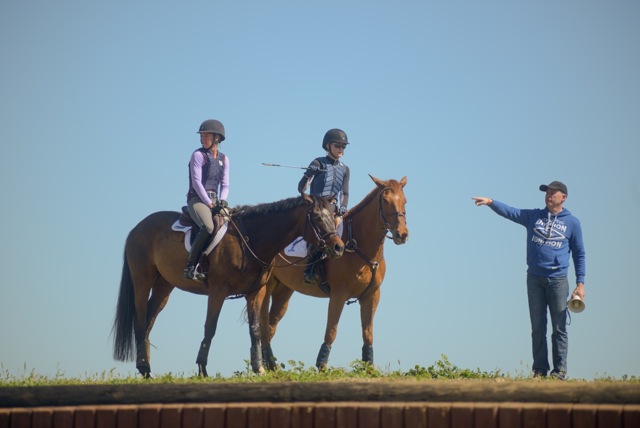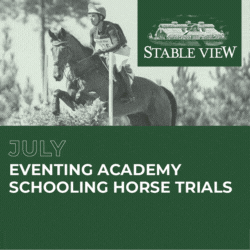German Olympic gold medalist Andreas Dibowski taught his very first clinic in the U.S. at Twin Rivers Ranch earlier this month, and Andrea Baxter and Bec Braitling kindly sent in a report, with photos taken by Holger Hoetzel. Thank you to Andrea and Bec for writing, and thanks for reading!
California riders were fortunate enough to take part in a three-day clinic with German powerhouse and Olympic gold medalist Andreas Dibowski, his first one in the U.S., earlier this month. The clinic was wonderfully organized by Holger Hoetzel, a German citizen who now resides in beautiful California.
Twin Rivers Ranch hosted the clinic, with one day of show jumping and two days of cross country, or as Andreas calls it, “the cross.” He also happily spoke Friday and Saturday night, sharing with us his methodologies and training programs. Needless to say, we pressed and pressed trying to extract the key to those Germans’ winning ways!
Day 1: Show jumping
Andreas set up some simple exercises in the big show jumping ring and kept it very basic. He wanted everyone to be focused on the details of their line, balance and energy.
The warm up consisted of raised cavalleti one stride apart on a circle. He insisted the horses carry a forward canter through the turn and to the poles so the horses could sit down and balance themselves instead of reaching and leaping through or over the poles. His main point was it’s the rider’s responsibility to create a good canter and the horse’s responsibility to move their feet.
We then moved on to a simple vertical facing the rail, where he wanted us to focus on landing straight and then turning as opposed to letting the rail force the horse to turn.
He was detail oriented and gave individual feedback after each exercise. We finished with a course, including a grid, related lines over a mound, a big oxer off a turn, and a triple combination ending with a related distance to an angled fence and two skinnies.
He incorporated cones throughout the course to make sure we were landing on the same line we took off from. Andreas got great entertainment from eliminating people for missing or skipping the “mandatory” cones (which a few horses enjoyed jumping!). It turns out he has an awesome sense of humor.
Day 2 and 3: “The cross”
Andreas was keen on stringing fences together to make short courses that were fun, inviting and ultimately challenging for each horse. He was very in tune with which horses could handle more or less of the challenges and would adjust the courses accordingly.
It was refreshing to be reminded by an outsider that certain questions on a cross country course are good schooling exercises for all horses despite the “level” of course its on. For example, he had the training horses warm up on lots of down banks in and out of water.
They were expected to jump the raised drop into water, which at a show when its dressed up and has a jump before it and probably after it in the water, its on the one-star course, but by itself as a raised drop fence, it’s a perfectly safe schooling question for green horses. It was funny to hear others say — and even the thought ran through my mind — “Yikes! That’s on the “___” course!” But the reality is there is no reason for us to not start introducing those questions when they are simple and not in combinations.
Each group schooled the down/up bank of the sunken roads, all the levels of ditches at the coffin, and he added in skinnies and angles for all the groups (with flags, of course). He insisted that all narrows be jumped with flags or wings every time. He said it was nonsense to ever allow a horse to make a mistake without flags.
Dibo was adamant that all riders stay forward thinking and never allow your hands to do the talking. He wanted everyone to really use their seat and legs and not to interfere with the hands and be picky. All this sounds very basic and obvious, but it’s always a good reminder, especially in a schooling environment. He reminded us all that schooling needs to be a positive experience, and we must ride with the same attitude schooling as we do on course in order to keep our horses confident and brave.
Lectures
Each night he had prepared a slideshow and had handouts for the lectures. Andreas was passionate about the importance of the horse’s balance, straightness, calmness, energy, tempo and trust. He went on to detail the responsibilities of the rider and horse as it related to line of direction, tempo, balance, fitness and one’s ability to self assess their own capability.
He showed a spreadsheet of his yearly show schedule for each horse, including backup plans and time off. He explained the importance of building a horse up in terms of confidence and fitness, and that he prefers a softer run leading into a big show such as Rolex or the World Equestrian Games. He also described the importance of giving the horse a break after a big show and then starting them back up with a softer run to regain any lost confidence.
He emphasized the importance of conditioning on varying terrain and reminded us all that cross country is not in an arena and our horses need to be conditioned to handle variations in footing.
Andreas was a wealth of knowledge and he was happy to be in sunny California working on his tan all while teaching a great group of eager to learn riders! He even talent spotted a couple horses that he wanted to bring back to Germany with him.
- Photo by Holger Hoetzel
- Photo by Holger Hoetzel
- Photo by Holger Hoetzel
- Photo by Holger Hoetzel
- Photo by Holger Hoetzel
- Photo by Holger Hoetzel
- Photo by Holger Hoetzel
- Photo by Holger Hoetzel
- Photo by Holger Hoetzel
- Photo by Holger Hoetzel
- Photo by Holger Hoetzel
- Photo by Holger Hoetzel
































